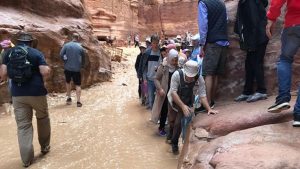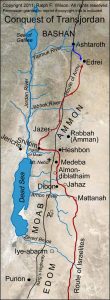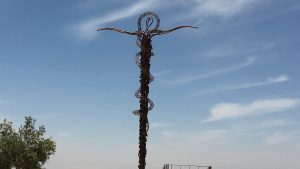
ANOTHER SQUABBLE over water points to the location of Mount Sinai being farther north than many think.
This week, we fast forward about 39 years to the fortieth year of the Israelites’ wanderings and discuss the second time Moses brought forth water from the rock called Meribah, which means “quarreling.” This site is also mentioned in Exodus 17:1–7.
“Behold, I will stand before you there on the rock at Horeb, and you shall strike the rock, and water shall come out of it, and the people will drink.”
Exodus 17:6 (ESV)
The difference between that event and the one we discuss this week is that Moses was told to strike the rock in Exodus, whereas in Numbers 20 he’s instructed to “tell the rock before their eyes to yield its water.” Instead, Moses strikes the rock twice with his staff, an act of disobedience that compels God to bar him from entering the Promised Land “b]ecause you broke faith with Me in the midst of the people of Israel at the waters of Meribah-kadesh, in the wilderness of Zin” (Dt 32:51), which is more evidence supporting the connection between Meribah, Kadesh, and Horeb/Sinai.
Note that Horeb is an alternate name for Sinai, which means Meribah must have been at Mount Sinai. The important point is that Numbers 20:1 places Meribah at or near Kadesh (i.e., Kadesh-Barnea), which means Sinai and Kadesh were in the same vicinity. Also, the reference to the Wilderness of Sin in Exodus 17 identifies it as the same place called the Wilderness of Zin in Numbers 20. (It’s also called the Wilderness of Sinai in Numbers 33:17.)
We believe Kadesh and Sinai are to be found at or near Petra in Jordan rather than the sites agreed upon by most researchers, who place Kadesh-Barnea in the Negev and Sinai either in the Sinai Peninsula or at Jebel al-Lawz in Saudi Arabia, both of which are too far south. Not only did the territory of Edom not extend beyond the northern shore of the Gulf of Aqaba, Jebel al-Lawz is too distant to allow for the Israelites to travel from Horeb to Kadesh-Barnea in eleven days (Deut. 1:1) at an estimated rate of five miles per day (allowing for children, the elderly, not to mention flocks and herds of livestock that needed to be fed and watered along the way).
We also discuss the strange incident with the “fiery serpents” (Hebrew seraphim nachashim) and explain why these were probably not venomous snakes, but supernatural entities of serpentine appearance.
Then we talk about the deaths of Moses’ siblings Miriam and Aaron, and we see God’s hand at work in directing the Israelites northward, around the territory of Edom, to do battle with the Amorite kings Sihon of Heshbon and Og of Bashan. We will deal with those battles in more depth in upcoming studies in the Book of Deuteronomy.
JOIN US IN ISRAEL! Our next tour of Israel is October 19–30, 2025. For more information and to reserve your place, log on to GilbertHouse.org/travel.
NOTE: If you’e going to Israel with us in October, you’ll need to apply for a visa online before you travel. The cost is 25 NIS (about $7.50). Log on here: https://www.gov.il/en/departments/topics/eta-il/govil-landing-page
The latest installment of Sharon’s Redwing Saga, King’s Gambit, is available now in paperback and Kindle! Visit Sharon’s author page at Amazon.com for more.
Derek’s novels The God Conspiracy and Iron Dragons are available in paperback and Kindle! See the official trailers and learn more at the website for Rose Avenue Fiction (www.roseavenuefiction.com).
Our book Giants, Gods & Dragons is available in Kindle and paperback! Get it as part of a great package with more than 27 hours of our video teachings at the SkyWatchTV Store or at Amazon.com.
Click here for the complete archive of our New Testament Bible studies to date, click here for the Old Testament studies to date, and click here for our studies of the Book of 1 Enoch to date. Or go to www.spreaker.com/show/gilbert-house-fellowship for all of the audio.



I studied for a year or two with Israel Bible Institute and the teaching about the site of the Crucifixion was on the mount of Olives. The point they made was that the Romans executed criminals at the place they were arrested. He would also have been able to look into the Temple and see the last sacrifice of the lamb there.